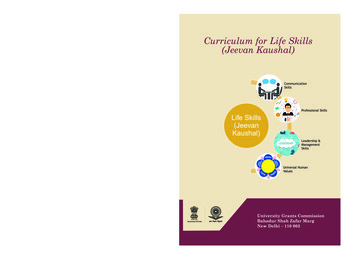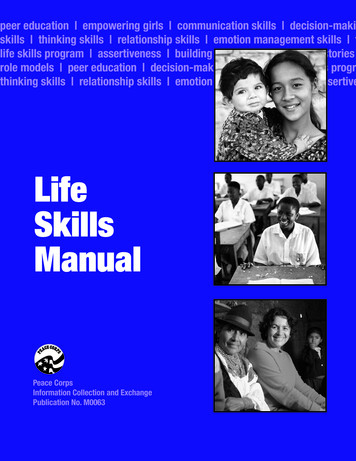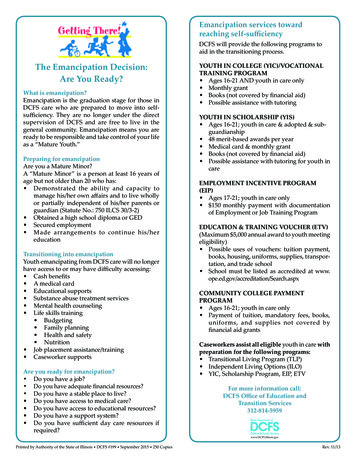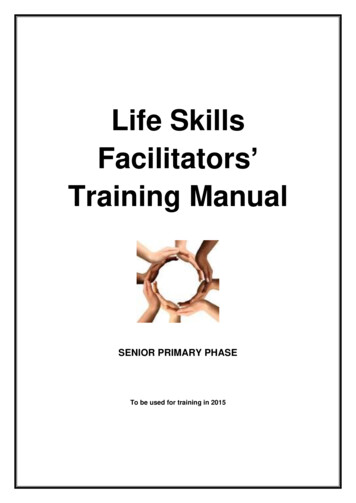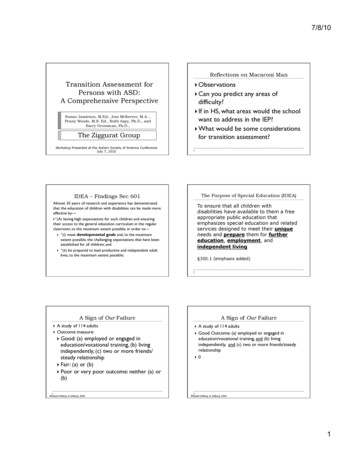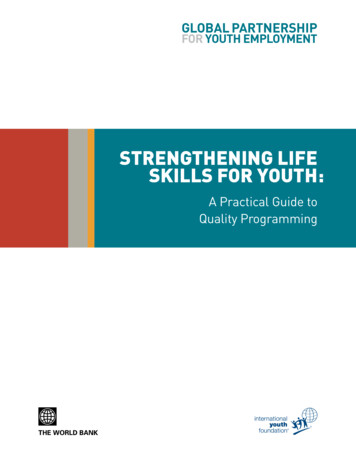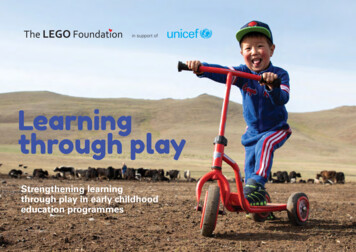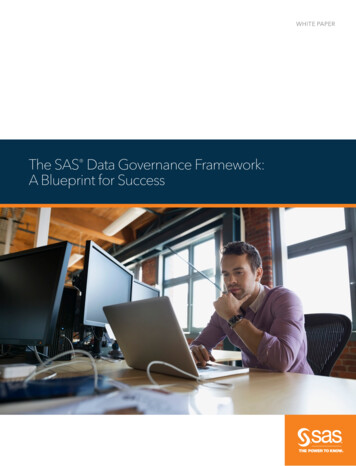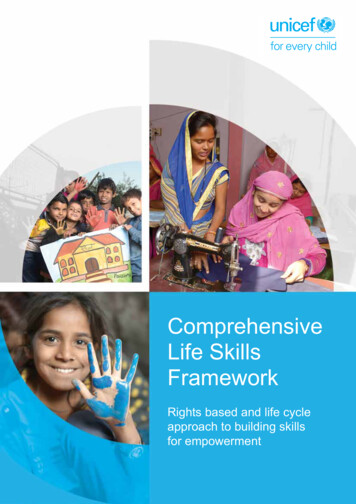
Transcription
ComprehensiveLife SkillsFrameworkRights based and life cycleapproach to building skillsfor empowermenti
ComprehensiveLife SkillsFrameworkRights based and life cycleapproach to building skills forempowerment
Comprehensive Life Skills FrameworkAcknowledgementsThe development of the Comprehensive Life Skills Framework was led by UNICEF India with contributionsto its development from National Council of Education Research and Training, Ambedkar University,Room to Read, Care India, Save the Children, Aga Khan Development organization, Enfold, Central Instituteof Education, Nirantar, Learning Link Foundation, Tata Trust, Breakthrough and Young Lives, UNESCO,World Bank2
PrefaceIntroductionInvesting in the world’s 1.2 billion adolescents aged 10-19 could break entrenched cycles of poverty andinequity. India is home to more than 253 million adolescents. Caste, gender, poverty and location continue topose barriers for many young people to realize their full potential.There is an increasingly stronger focus on developing comprehensive life skills in children and young people inIndia so that they are empowered and are responsible citizens of society. In addition to academic, vocational,and technical skills, the focus is now on building those skills or competencies that are needed to meet thedemands of the increasingly vulnerable situations of our diverse societies.In India’s complex and diverse scenario, life skills have inherent attributes to elicit empowerment and activeparticipation from children and adolescents, helping them recognize their power and potential and take positiveaction to promote social inclusion, harmony and promote equal opportunities for all.There is evidence that psychosocial competencies, including resilience, personal agency and self-confidence,can help a person move out of poverty and life skills can enable young people to protect themselves from amultitude of vulnerable social environments and risk-taking behaviours.Therefore, young people must be provided the opportunity to gain knowledge and develop relevant values,attitudes and skills that will enable them to participate fully in their society and to continue learning. Developinglife skills amongst them is critical to addressing the Sustainable Development Goals.Research indicates a positive correlation between life skills and increased attendance levels, enhancedclassroom behaviour and improved academic achievement. Given the positive correlation between life skillsand learning outcomes, the role of life skills education within school curriculum and in the community becomesvery important.Endorsing the need for a broader and integrated approach to life skills, a comprehensive framework to fashionpolicies and programmes that mainstream life skills both in schools and in communities is critical. UNICEF Indiahas consolidated the efforts by various agencies to bring together a comprehensive framework on life skillsthat can be used to achieve a defined goal for individuals at specific age group across the life cycle. The effortis to make this framework consistent with global and national perspectives on the skills and characteristicsthe children and youth of today need for the future, and to the national situations, with a specific focus onthe marginalized communities. The framework is primarily built on a strong Rights based and Empowermentapproach, supporting children and adolescents in India to address vulnerabilities, lead informed lives, takedecisions, and be responsible citizens.The objective of this paper is to emphasize and delineate the need for life skills in India while coming togetheron common definition of life skills to be referenced across development sectors. The paper further developsthe theory of change and builds a conceptual framework for life skills that embed a set of skills-clusters that aremost relevant in the Indian context. It further affirms the importance of operationalizing life skill developmentas part of a continuum approach, as life skills are life long and must be developed early and implementedthrough all stages of life.3
Comprehensive Life Skills FrameworkThe paper has been informed by a series of workshops and discussions led by the United Nations Children’sFund (UNICEF) India in collaboration with partners in the country, especially the National institutes, UN sisteragencies, civil society organizations, academia, and independent experts.The target audiences for this paper are policy makers, teacher educators and other groups (governmentaland non-governmental) that work with teachers, frontline workers and other functionaries in education, health,protection and nutrition; and organisations active in these sectors. The focus of the paper is conceptual andtheoretical based on which guidelines for implementation will be prepared.4
Content1.Defining Life Skills62.Need for Life Skills in India93.Theory of Change144.Life Skills in Indian context185.Life Skills Continuum216.Conceptual Framework257.Operationalization35References395
Comprehensive Life Skills Framework1 UNICEF/UNI130598/VishwanathanDefiningLife SkillsComputer class – Udaipur6
Defining Life SkillsLife skills are a set of abilities, attitudes andsocio-emotional competencies that enableindividuals to learn, make informed decisions andexercise rights to lead a healthy and productive lifeand subsequently become agents of change. Lifeskills promote mental well-being and competence inyoung people1 as they face the realities of life. Theseskills support the development of foundational skillssuch as literacy, numeracy, digital skills2 and canalso be utilized in several areas, such as genderequality in education, environmental education,peace education or education for development,livelihood and income generation, and for positivehealth promotion among others. Life skills empoweryoung people to take positive action to participate intheir communities, engage in continuous learning,protect themselves and promote health and positivesocial relationshipsThe term ‘life skills’ has been defined by variousorganizations in respect to the context that the termOn the same lines, however broader and applicablebeyond health domain, the World Bank, through thelens of gender norms and human rights, defineslife skills as a set of social and behavioural skillsalso referred to as “soft” or “non-cognitive” skillsthat enable individuals to deal effectively with thedemands of everyday life.UNICEF’s Middle East and Northern Africa (MENA)framework provides an all-encompassing definition3that states development of life skills as a processto be applied to various learning areas coveringfour dimensions: the cognitive, the individual, thesocial and the instrumental. Life skills are regardedas a cross cutting, interconnected and overlappingapplication of knowledge, values, attitudes andskills which are integral to quality education and areuniversally applicable and contextual.UNICEF, Adolescent and Youth Engagement StrategicFramework Adolescents: 10-19 years, Youth: 15-24 years andYoung People: 10-24 years, which is the term that covers alladolescents and youth.2Also referred to as basic cognitive skills in the 2016 GEM Reportin “improving workd outcomes among Young people: what role ofskills?” UNICEF HQ/Education Development Trust March 20173http://www.lsce-mena.org/1 UNICEF/UN0280976/VishwanathanDrawing from the above, life skills are a setof abilities, attitudes and socio-emotionalcompetencies that enable individualsto learn, make informed decisions andexercise rights to lead a healthy andproductive life and subsequently becomeagents of change.is applicable to their own programmatic focusesand strategies. For example, the World HealthOrganization (WHO), considers life skills in the specificcontext of health and defines them as abilities thatsupport adaptive and positive behaviours that enableindividuals to deal effectively with the demands andchallenges of everyday life.Children learn paper cutting during a session at the Child Friendly Space (CFS) – Jammu and Kashmir7
Comprehensive Life Skills FrameworkThe concept of life skills has acquired differentmeanings and connotations driven by variedinterventions aimed at development of specificskills such as livelihood skills, technical skills,abilities, health, gender equality, leadership andothers. The term became popular as an importantcomponent of interventions in health, reproductivehealth and HIV/AIDS and comprehensive sexualityeducation. Thus, the term is so broad as opposedto restrictive/defined that different organizationsundertake multiple/different activities under thename of life skills.UNICEF’s derived definition necessitates furthernarrowing down this term to focus on specificgamut of skills necessary for overall developmentand empowerment of an individual. The skills aredirected to capacitate and enable individuals toengage in changing social inequalities to lead moreinformed, proactive lives in their personal, socialand community context and gain control over theirlives. That means narrowing down the definition oflife skills and conceptualizing universal skills thatare most essential for individuals to function, thriveand adapt in their lived realities.The knowledge, skills and attitudes (KSA) approachcould bring about the change envisaged whenindividuals apply these skills. Establishing baselineunderstanding of knowledge (what one knows), skills(what one can do) and attitudes (what one believesand values) help practitioners be more purposeful notonly when reinforcing life skills but also when applyingsuch competencies to help children and young peoplenavigate unique challenges at pivotal momentsacross individual’s life and in different contexts4.Embedded in the Sustainable Development Goals (SDGs) There is a broad consensus on type ofskills needed.FOUNDATIONALliteracy, numeracy and increase digital skillsTRANSFERABLEcan be applied in different situations such as communication, creativity, problemsolving, empathy, respect for diversity and critical thinkingJOB-SPECIFICallows performance in a particular job such as carpentry, coding, accounting orengineering. Can become outdatedLife skills are the skills necessary to acquire all the other three categories of skills.These constitute important constituents of the 21st century skills. (refer section4-life skills in Indian context).48Kwauk C & Braga, 2017 Life skills education is more than teaching skills, Brookings institution Washington DC
2 UNICEF/UNI70222/BiswasNeed for LifeSkills in IndiaAdolocent life skill training programme(SPARSH) ,Pimpalgaon. A local boy admires a picture Alyssa Milano took of him – Maharashtra9
Comprehensive Life Skills FrameworkThree core issues impacting the Indian landscapeare inequity, fragile knowledge society anddepleting human capital, and all are synergisticand interdependent.InequityThe gross enrolment ratio (GER) leans towards boysat the primary level, but drops for all children asthey move from primary to lower secondary and to UNICEF/UN0278308/NarainPost-independence, patterns of inequality andexclusion continue to exist in India, largely due todeep rooted social (e.g. caste, tribal, minorities andgender) and class structures that perpetuate andlimit opportunities for people, systematically blockingthem from availing of the rights, opportunities andresources that are usually available to all membersof society. Within these groups, girls are furtherdiscriminated due to their sex. The degree towhich the inequity exists varies between regionsand geographies.India’s total population at 1.2 billion (2011 NationalCensus) with 20.9 percent (253 million – 133.4 millionboys and 119.8 million girls) younger than 18 years,makes it a home to the largest number of childrenin the world, with about half of these belonging todisadvantaged groups such as Scheduled Castes(SC), Scheduled Tribes (ST), and minorities. Girlsstart to drop out as they move across the educationlevels, SC, ST and rural areas reflect the disparitymore. While 70 percent of the total number of 3 to6 years old children are attending pre-school, 20million children are still not attending preschoolare predominantly girls from the poorest families,Muslims and those who live in rural areas.Girl rescued from child trafficking and is now working in Beti Zindabad Bakery whose mission is to retain the youth in their villages so thatthe girls are employed10
Need for Life Skills in IndiaChildren from Muslim, SC and STcommunities, particularly girls, makeup most of the out-of-school children(67 percent) population in India,although they only make up 40 percentof the child population, indicatingtheirdisproportionateexclusionfrom education.secondary levels. (Educational Statistics at a glance,2014 & 2016, MHRD, Govt. of India).Children from Muslim, SC and ST communities,particularly girls, make up most of the out-of-schoolchildren (67 percent) population in India, althoughthey only make up 40 percent of the child population,indicating their disproportionate exclusion fromeducation. Girls, rural children and those belongingto lower wealth quintiles are more disadvantagedand likely to account for a much larger proportion ofout-of-school children5. Gender inequalities interlockwith other forms of social inequality, notably caste,ethnicity and religion, with girls from ScheduledCastes, Scheduled Tribes and Muslim minorities, inparticular, constituting the largest population of outof-school and dropout children6. Many girls havenever enrolled in schools and the transition rates donot acknowledge this number across all grades.Adolescent girls and boys experience multiple layersof vulnerabilities based on sex, age, caste, socioeconomic status and geography. Adolescent girls willface bigger challenges in this transition, as they facemultiple deprivations in India. Girls are discriminatedagainst in India at all stages of the life cycle, startingwith sex-selective abortions, higher female infantmortality, higher anaemia, lower secondary schoolcompletion and an overall lower investment ofhousehold resources for daughters than sons. Theonset of puberty reduces girls’ freedom, mobility andincreases their unpaid care work in the household.Girls and boys are also socialized to aspire fordifferent adulthoods. Boys expect to become selfsufficient and economically productive while girls are56expected to become wives and mothers, sometimeseven below the age of 18. As families move outof poverty, this leads to one of the lowest femalelabour force participation rates in the world that hasfallen in recent years. Where girls and boys expressaspirations for jobs, they generally tend to opt forgender-traditional/stereotyped careerss. Boys aspireto be constables and doctors, girls aspire to benurses and teachers.Caste, religion and geography multiply these genderdeprivations and in some cases, boys are more likelyto drop out of secondary school and be recruited intoviolent local movements. The three most pressinggender-based deprivations for Indian girls and boysare: (i) Ability to postpone age at marriage (ii) Violenceand the fear of violence, especially in preventing girls’ability to access services and (iii) Knowledge, skillsand networks to imagine, aspire and prepare for anadulthood that is different from their parents’.Fragile Knowledge SocietyKnowledge is the core of a productive society,however the ability to learn and apply critical thinkingskills to solving problems (both defined as “skills”) ismore important than the accumulation of knowledge.This ability supports the individuals to invent andinnovate, leading to social and economic growth.In India, children and adolescents have low levels ofunderstanding and conceptual clarity around learning,analytical skills and knowledge of human rights,including gender equality. National AchievementSurvey (NAS), State Learning AchievementSurveys (SLAS), Annual Status of Education Report(ASER) and Programme for International StudentAssessment (PISA) are large scale assessmentsthat have consistently pointed to the poor learninglevels of children in language and mathematics evenafter eight years of education. Most of these childrenlive in the states of Rajasthan, Madhya Pradesh,Uttar Pradesh, Chhattisgarh, Jharkhand, Bihar,Odisha and Andhra Pradesh and are from SC, STand minority communities.Malnutrition and stunting affects 38 percent childrenunder five in India and also impacts mental/cognitivedevelopment, so it affects their ability to learnand eventually negatively impact’s child’s futureproductivity potential.UNICEF-USI (2014) report on out-of-school children in IndiaBandyopadhyay and Subrahmanian (2008)11
Comprehensive Life Skills FrameworkMore rural adolescents are not promoted to furthergrades because they struggle with reading, math;with girls it is worse off. This makes girls especiallyvulnerable to dropping out from school. Those whoare enrolled in school or college are less likely to workin the same time (61.5 percent), and those who werenot enrolled, ended up working instead (60.2 percent).Thus, young people facing inequities and exclusionare particularly incapacitated from creating,accumulating and using knowledge, resulting in afragile knowledge society.More than 12 million young girls and boys between15 and 29 years of age are expected to enter India’slabour force every year for the next two decades.The government has pledged to skill 500 millionpeople by 2022 as a part of the Skills India Mission.This should be put in a context where 90 percent ofthe workforce is in the informal sector and millions UNICEF/UN0278918/KatragaddaOlder adolescents (14-18 years of age) in rural areasare not learning in schools and are not equippedwith skills and abilities they will need to be readyfor productive lives as adults7. The enrolment gapbetween males and females in the formal educationsystem increases with age. At age 18, 32 percentfemales are not enrolled as compared to 28 percentmales. At age 14, the percentage of youth notenrolled is 5 percent. By age 18, this figure increasesto 30 percent. As they grow up, more girls drop outof school in rural areas, 86 percent of youth in the14-18 age group are still within the formal educationsystem, yet, a substantial proportion of them arealso engaged in unpaid work (42 percent), mostly inagriculture or household chores. Most 14 to 18-yearolds can use cell phones but cannot read basic texts.Learning deficits carry forward as 14 to 18-year-oldsgo from being adolescents to young adults showinginability to apply basic literacy and numeracy skills toeveryday tasks.Mohit Uikey, 8, demonstrates during a practice session of the Tinka Samajik Sanstha martial arts training program. Tinka Samajik Sansthawas started as platform to give self confidence and fight against harassment. The program is determined to equip self defence skills toboys. Anchor Ritesh Tiwari was one of the awardees of first The ChangeLoomers Fellowship initiated by Harda (MP) based SynergySansthan, an NGO working for youth based. The award money is supported by UNICEF’s mentorship initiative in Madhya Pradesh thataims to strengthen the voices of young adults and builds their leadership skills.712Annual Status of Education Report (ASER) 2017
Need for Life Skills in IndiaDepleting Human CapitalThus,youngpeoplefacinginequities and exclusion areparticularly incapacitated fromcreating, accumulating and usingknowledge, resulting in a fragileknowledge society.of young people are expected to migrate to urbancentres. India’s Female Labour Force Participation(FLFP) is one of the lowest in the world, ranking 121out 131 countries with a decline from 42.6 percent in1993-94 to 27 percent in 2015. According to a WorldBank study, between 2004 and 2012, 19.6 milliongirls and women dropped from labour force, mainlyin rural areas. The best available evidence pointsat acceptability and value of female employment aswell as change in the aspiration of young womenas critical determinant in the current decline inwomen’s participation in the workforce. Many criticaldecisions that impact a woman’s life are made in heradolescence without her.8A fragile knowledge society has ramifications on theability of its members in understanding and applyinglearning to gain opportunities and build a productivesociety. This is driving inequalities in health, educationand life chances and is most pronounced in somestates and pockets of India.The country is experiencing abject poverty ions, where young people do not havenecessary skills for productive employment andlivelihoods and lack key competencies alignedwith the changing demands of the dynamic marketand lack workforce readiness. This is drivinginequalities in health, education and life chancesand is most pronounced in some states and pocketsof India. These skills have been recognized as thepsychosocial competencies and interpersonal skillsthat help make informed decisions, solve problems,think critically and creatively, communicate effectively,build healthy relationships, empathize with othersand cope with and manage their lives in a healthyand productive manner8.Dewan S, Sarkar U, From education to employability: Preparing South Asian Youth for the world of work, UNICEF 201713
3 UNICEF/UNI106348/CrouchTheory ofChangeStudent Mahesh Kushwaha (aged 13, yellow t-shirt) and fellow students show off soaps brought from home to use for hand washing skillsbefore lunch at Tinsyahi School in Guna District, Madhya Pradesh. A UNICEF program to encourage personal hygeine, hand washingand latrine usage is reaping rewards in the form of diminishing cases of serious illness associated with poor hygeine. With the objectiveof promoting life saving behaviour and skills in young children – Madhya Pradesh
Theory of ChangeEmpowerment is a personal journey through whichan adolescent girl or boy develops a clear andevolving understanding of themselves in the world,accompanied by increasing agency and assets.Empowered adolescents recognize their inherentworth, the fundamental equality of men and women,boys and girls. They critically examine their livesand the inequities in their societies. They participatecivically and make personal and public choices toact for the improvement of their lives and their world.Kabeer (2001) said, “Empowerment is the expansionin people’s ability to make strategic life choices in acontext where this ability was previously denied tothem.”They can critically examine their lives and broadersociety and take action towards personal and socialtransformation9. This leads to fostering equitable andknowledge based societies and building strongerhuman capital.The theory of change rests on the premise thatproviding equitable and quality learning opportunities,A higher-order theory of change as articulated inthe UNICEF’s Global Framework is applicable tothe Indian context as well.The theory of change is that the systematicdevelopment of a breadth of skills, at scale, acrossthe life course of the learner requiresEffective pedagogical strategies such as learnercentered approaches which depend largely on theenabling role of teachers and facilitators. It alsorequires the age appropriate learning materials tosupport the pedagogies.Enabling environments where all learnerscan participate and feel physically, socially andemotionally safe.A multiple pathways approach with a focus onformal education delivery as on non-formal andinformal education channels including the roadto and in the workplace, which will ensure equityand inclusion.Opening Minds, Improving Lives: Education and Women’sEmpowerment in Honduras, Murphy-Graham (2012)9 UNICEF/UN0280974/VishwanathanEmpowerment is the expansion inpeople’s ability to make strategic lifechoices in a context where this abilitywas previously denied to them.resources and supportive opportunities will developlife skills, which multiplied with advocacy, enablingenvironment and system support will lead to learningand empowerment of children and young people.Children react during an activity at the Child Friendly Space (CFS). The Child Friendly Spaces initiative began with 20 pilot CFS in thedistricts of Srinagar and Budgam, covering 1,000 children. Community mobilisers were trained in skill development programme to be ableto work with children in such an environment – Jammu and Kashmir15
UNICEF/UN0267905/Akhbar LatifComprehensive Life Skills FrameworkGulshan Kandagiri, an 8th grader and the Deputy Chief Minister of the Child Cabinet, takes the lead in demonstrating and motivating thecommunity with an easy and correct way to keep healthy, by using the prescribed six step hand washing process – OdishaA systems approach which addresses theinclusion of skills in national policies and plans,curricula frameworks, coordination and partnershipframeworks, budgeting and financing, humanresources and capacity development, M&E andcertification frameworks.And that this development of skills will contributeto achieve tangible outcomes in four separate yetinter-related areas:The achievement of a knowledge societythrough improved education outcomes. Thereis an imperative for India within an increasinglycompetitive and globalized world, to improvethe quality of education at all levels, in particularto develop relevant learning outcomes for thetransitions from school to work and adult life. Thisoutcome reflects the ‘Learning to Learn’ pillarsuggested in the Delors Report.The realization of economic rship. With high youth unemployment,a widespread economic and societal issue in16India, as well as the requirements of the FourthIndustrial Revolution (Schwab, 2016), substantialpressure is put on education systems to betterprepare youth with the skills to navigate this complexnew environment (Partnership for 21st Century Skills,2008). The skills that are useful for labour intensiveor even technology intensive industries are nolonger sufficient for economic competitiveness andthe knowledge economy. This outcome reflects the‘Learning to Do’ pillar suggested in the Delors Report.The attainment of enhanced social cohesionthrough improved civic engagement. Socialcohesion and inter-connectedness need to besupported by individuals, who chose to positivelycontribute and participate in their community. Withinthe theory of change, social cohesion throughimproved active citizenship has significant educationimplications regarding the preparation of youth tobecome active citizens. It reflects the ‘Learning toLive Together’ pillar suggested in the Delors Report.The empowerment of each individual throughlife skills so they can develop a clear and evolvingunderstanding of themselves in the world,accompanied by increasing agency and assets.The ‘Learning to Be’ pillar in the Delors Report.
Theory of ChangeStrategies Effectivepedagogicalstrategies aslearner-centeredapproaches Enablingenvironments whereall learners canparticipate and feelphysically, sociallyand emotionally safe. A multiplepathways approachwith a focus onequity and inclusion A systemsapproachInputs Teacher trainingincludes learnercentered approaches Establish enablingrole of teachers andfacilitators. Age appropriatelearning materialsto support thepedagogies. Life skills integratedin formal educationdelivery Life skills deliveredthrough nonformal and informaleducation channels Programmesleading to and in theworkplace Inclusion of skillsin national policiesand plans, curriculaframeworks,coordinationand partnershipframeworks,budgeting andfinancing, humanresources andcapacity development M&E and t of abreadth of skills, atscale, across the lifecourse of the learnerOutcomeThe achievement ofa knowledge societythrough improvededucation outcomesChildren and youngpeople express, interactand participate acrossplatforms and spacesParents andCommunities Access information Know positive skills,support development,value of education,well being of girls andboys Know to recognizeand prevent risks Support childrenand young people toprovide/access lifeskills programmesand services Community-basedstructures in placeand functioning tocreate protectiveenvironmentService providers Government able topromote access anddeliver quality lifeskills programmes Local authorities ableto address childrenand young people’sissues Support children’senrolment andtransition at all levelsof schoolingThe realizationof economicdevelopment throughimproved employmentand entrepreneurshipThe attainment ofenhanced socialcohesion throughimproved civicengagementThe empowermentof each individualthrough life skills17
Comprehensive Life Skills Framework4 UNICEF/UN032724/SinghLife Skillsin IndianContextStories are wonderful vehicles. They can transport you to a different world, one with endless possibilities. Seventeen-year-old Lipika Murahunderstands the significance of these fantasy tales-not just for entertainment, but also for steering change in children’s lives - Assam18
Life Skills in Indian ContextTBESelfawarenessLEARNegotiationNTOARThere are a cluster of 10 total coreskills separated into each of thesedimensions and all dimensionsare interdependent and overlapone another.GNIGTO1. Empowerment: Self-Awareness,Communication, Resilience2. Citizenship: Empathy, Participation3. Learning: Critical thinking, Creativity, ProblemSolving4. Employability: Negotiation, Decision-makingINNhere are four dimensions of skills: Empowerment,Citizenship skills, Learning skills and Skills forEmployability10. There are a cluster of 10 total coreskills separated into each of these dimensions andall dimensions are interdependent and overlap oneanother. For example, negotiation and decisionmaking skills under the employability dimensionare also relevant under other dimensions such asempowerment and social skills, as they are
life skills as a set of social and behavioural skills also referred to as “soft” or “non-cognitive” skills that enable individuals to deal effectively with the demands of everyday life. UNICEF’s Middle East and Northern Africa (MENA) framework provides an all-encompassing definition3 that states


